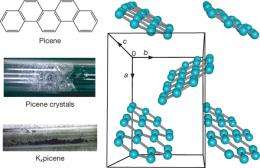March 10, 2010 report
Hydrocarbon superconductor created

(PhysOrg.com) -- Scientists from Okayama University in Japan have discovered that the hydrocarbon picene can be made to superconduct when potassium atoms are interspersed with the picene crystals and the doped picene is cooled.
Electricity flows through a superconductor with no resistance when the material is chilled to below a transition temperature (Tc). The phenomenon was discovered in 1911 by Dutch scientist Heike Kamerlingh Onnes, who demonstrated the lack of resistance by creating an electrical current in a closed loop of a mercury superconductor. After the driving potential was removed, the current continued to flow even on the journey from the Netherlands to England.
Picene (C22H14) is an organic compound found occurring naturally in coal tar, and in residues of the petroleum refining process. It is usually a semiconductor, but the researchers, led by Yoshihiro Kubozono, found that when synthesized picene is doped (intercalated) with atoms of an alkali such as rubidium or potassium it became a superconductor with a Tc of 18 kelvin (-255 degrees Celsius) or below, which is a relatively high temperature for superconductors. Professor Kubozono said picene is the first example of a hydrocarbon superconductor, although scientists have been able to create superconductors of the carbon compound fullerene (C60) doped with potassium.
The picene molecule resembles five benzene rings joined in a staggered line, and is a flat molecule that stacks into layers to form crystals. The researchers cooked picene with potassium, which forced the alkali atoms between the layers and improved its conductivity in planes parallel to the layers.
The researchers are now trying other metals with picene, including cesium and sodium, and are testing other hydrocarbons for superconductivity. Their research paper is published in Nature. A commentary in the journal, by Kosmas Prassides of Durham University, described the work as "exciting news for superconductivity researchers". He predicted it would stimulate more work on hydrocarbons to confirm the work of the Japanese researchers and to find other hydrocarbons that can be coaxed into becoming superconductors.
More information: Superconductivity in alkali-metal-doped picene, Ryoji Mitsuhashi et al., Nature 464, 76-79 (4 March 2010). doi:10.1038/nature08859
© 2010 PhysOrg.com

















